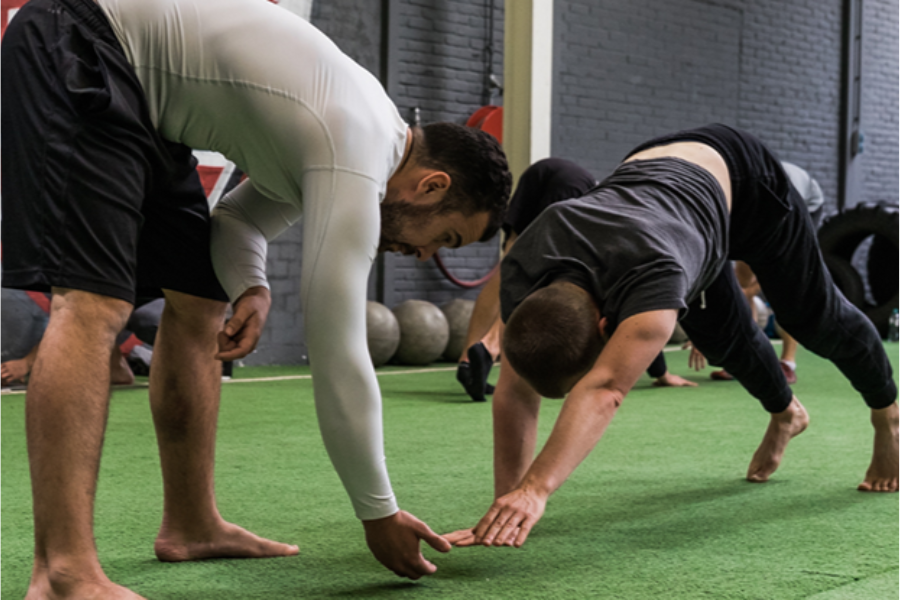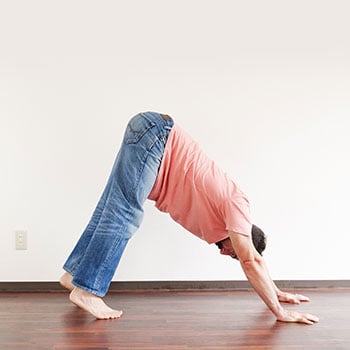You want to move and feel better—we all do! So how do we get there?
First, you need to get specific about what you want. That’s pretty straightforward if you have a movement or exercise goal, but even if it’s something general like losing weight or building some muscle, it’s best to have a concrete target to work toward.
We’ve found that the best goals focus on enhancing how your body moves and feels—in movements like squats, lunges, pull-ups, push-ups, and even handstands and cartwheels.
So, we’ll concentrate on the most effective ways to improve your movement capabilities.
Mastering movements and achieving goals comes down to having a specific plan you can follow that lets progress happen naturally and efficiently.
Of course, you want results as quickly as possible, but there’s a right way and a wrong way to go about it. You could knock a hole in a wall by banging your head against it, but it would be much easier—and less painful—with a sledgehammer.
Both your head and the hammer can get the job done, but one is far more effective and significantly less painful than the other.
Then break that down further:
- Progress isn’t a straight line and that’s ok
- Why good enough is the key to eventually being great
- Our framework that won’t fail, applied to any movement
And finally how to personalize it for your needs:
💡 Three Steps Forward to Progress
Simplify Your Training to Achieve Better Results
The first step is to stop constantly switching programs or continually adding exercises. It not only doesn’t help, it can make you worse. It’s easy to get caught up in the latest trends and feel overwhelmed. But here’s the truth: you don’t need all that extra fluff.
Currently, I use a variation of our Integral Strength program Monday through Friday. That’s it. No need to pile on random exercises or bounce between trends. I focus on what serves my goals and cut out the rest.
If you’ve ever felt overwhelmed by trying to “do it all”, trust me—you’re not alone. You don’t need to do it all, you need to do it better.
Pick a Routine—and Stick to It
You don’t need more motivation to achieve better results; results happen when your habits align with your goals. The ideal isn’t about being amped up and ready for action every single day. Instead, it’s when working out becomes as habitual as putting on your shoes before leaving the house—it’s just something you do.
This way, you won’t have to rely on motivation or “feeling ready.” Some days you’ll feel fantastic; other days, not so much. But because you’re accustomed to starting no matter what, you’ll likely keep going and see it through. So instead of worrying about whether you’ll crush it every day, focus on building the habit of beginning your training.
The workout itself matters—it absolutely does—but nothing will happen if you don’t show up. The magic is that once you get started, momentum takes over.
Trust the Process
Now, here’s what prevents many people from progressing: they start off excited but soon begin second-guessing themselves. This leads them to hop from one program to the next before they’ve even seen if the first one actually works!
This turns into a vicious cycle—they don’t see progress, lose patience, and keep searching for the next better solution. From an outside perspective, it’s clear this approach isn’t helpful at all. You need to give whatever program you choose a real shot.
Along the way, you might need to tweak things—this is autoregulation—but that’s simply smart training. The key is to stay the course. Our clients who follow our programs through to the end always come out more physically and mentally capable than when they started. Trust the program, trust the process, and you’ll get to where you want to be.
💡 Linear Progress is Not Always Practical
 One of the hardest things to do is measure progress with bodyweight training. When using weights and machines, you have a clear indication of whether or not progress was made. You either add weight to your lift, or you do more reps than you did last session.
One of the hardest things to do is measure progress with bodyweight training. When using weights and machines, you have a clear indication of whether or not progress was made. You either add weight to your lift, or you do more reps than you did last session.
And in a perfect world, you would add weight and reps ad infinitum to the point you’re lifting all the weight in the gym, yet our bodies are naturally limited in strength and ability so this process cannot last forever. But measuring your progress with bodyweight training doesn’t afford you this luxury of turning your brain off and simply adding more weight.
When you’re working on making progress with your movement practice, you’re going to reach major plateaus in your training. It might take you months of training before you can do your first pull-up. That’s actually very common! Then you go for two pull-ups in a row, then three and four and so on. Eventually you’ll hit a wall with number of repetitions as your benchmark.
So how can you approach progression using only bodyweight training?
How The Body Adapts With Bodyweight Training
Since you can’t rely on a metric like adding more weight or doing more reps, it’s important to consider three variables:
- Exercise progress
- Physique changes
- Performance improvements
Exercise Progress Over Time
 When you start practicing an exercise that you’re not very good at, you’re going to notice a lack of strength, control, and coordination. Let’s take push-ups for example.
When you start practicing an exercise that you’re not very good at, you’re going to notice a lack of strength, control, and coordination. Let’s take push-ups for example.
You may not have the strength to do a full push-up. So you would start by doing a modified version with your knees on the floor and you’d lower yourself as far as you can under control and then return to the starting position. Your first try might feel very hard. Your hands and wrists hurt, arms are shaking, and you really feel the weight of your own body. But in time, it’ll get easier and eventually you’ll be doing multiple push-ups in a set.
Physique Changes
The next thing you’re going to notice is physical changes. This will be more apparent if you’re out of shape, but most everyone will see changes in their body when you start pushing toward physical goals. Many people start to notice changes in their arms and legs when they start challenging themselves with push-ups, squats, and pull-ups. Another thing you might notice is your clothes fitting differently.
They might start getting looser in the thighs and waist as your body composition changes, even though their weight stays the same. That’s a good thing!
Performance Improvements
This is where this whole process gets fun. When we think of our programs as a whole, of course we want to move better while exercising but it must transfer to everyday life.
But what is performance improvement, really?
It’s the process where you begin to notice any activity or movement that was once hard getting much easier, sometimes in a short period of time.
Our clients tend to tell us about the things they can now do as a result of going through our programs.

Maybe your goal is to not feel any pain in your hips, knees, and ankles when you squat down to pick up your kids or haul in the groceries. So the training you do must support that goal. And as you carry on with everyday life, you’ll start to see whether or not the training is having an impact (it will).
If you start to notice that you don’t brace yourself when you have to pick up your dog to put him in the tub, it’ll be a sign your training is paying off.
This is why in all of our programs, we emphasize measuring and assessing your quality of movement in every session. This helps you to know how you are doing and improves your self-awareness so you can stop doubting yourself.
The Good Enough Principle
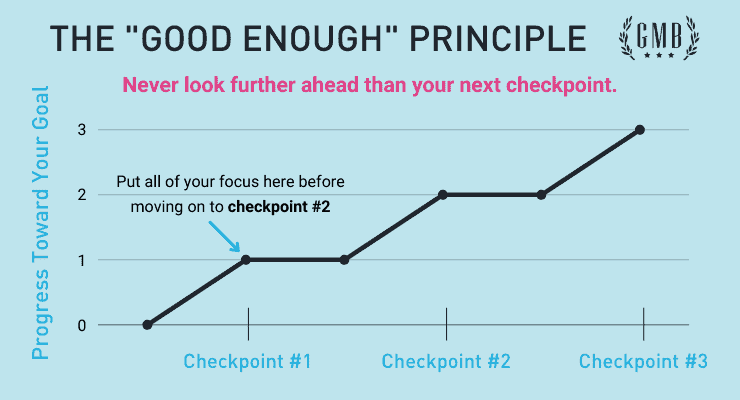 Let’s say you want to crush a big goal, like a one-legged squat (shrimps are my fav), or pull-ups from a dead hang. If you haven’t ever been strong enough to do either of these, you’re going to have your work cut out for yourself.
Let’s say you want to crush a big goal, like a one-legged squat (shrimps are my fav), or pull-ups from a dead hang. If you haven’t ever been strong enough to do either of these, you’re going to have your work cut out for yourself.
So instead of setting your sights on the end goal and only that, we want you to focus on getting ‘good enough’ for the time being. Being good enough means you aim to make progress, no matter how big or small, and only focus on getting to that next step. Once you hit that checkpoint, you can focus on the next one.
Let’s say your big goal is to perform a pistol squat. These are tough. And many things have to happen before you have the strength and coordination to squat down on only one leg. For example, can you squat well already? If not, why not? You probably have something that restricts your movement. Almost everyone does.
It could be your ankles, knees, hips, or you might lack some balance. Regardless, of what it is, you need to start where you are… and now we’ll give you the exact steps to go about reaching this big goal you’ve set for yourself.
The AAA Framework for Mastering Any Movement
For our example, we’ll keep the big goal of a pistol squat in mind. We approach movement master using the acronym, AAA, and it consists of 3 steps.

Because sometimes, life is easier when you got a map.
- Assess your current abilities in light of your goal (a single leg squat).
- Address whatever’s holding you back using the most efficient approach.
- Apply your new abilities to daily life, higher level training goals, whatever you want.
Here’s how it works in real life:
First, you have to assess where you are with a basic bodyweight squat. The right assessment will help you determine what’s holding you back. Here’s a very common situation, when people first look at their ability to squat, they notice hip and ankle tightness. This certainly will affect how you can squat!
Now you know what to address what’s holding you back. This means spending the appropriate amount of time to improve hip mobility and actively work on feet and ankle flexibility. It can take some time, but it will be well worth it. And you’ll notice in our programs that it’s not all you do, it is integrated into a comprehensive program.
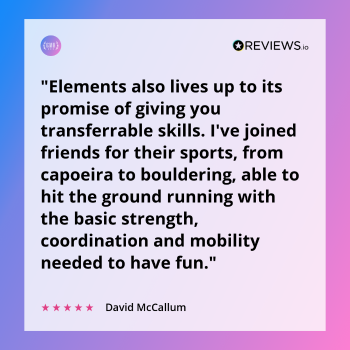 Once you’re aware and have begun addressing any issues, you then apply what you’ve gained to daily life and other training goals. Where is it useful to have a good squat position? Basically all sports and activities where you have to get up and off the ground with ease!
Once you’re aware and have begun addressing any issues, you then apply what you’ve gained to daily life and other training goals. Where is it useful to have a good squat position? Basically all sports and activities where you have to get up and off the ground with ease!
This leads us to all the other goals you want to work on, so let’s look at this from a practical point of view.
Goal Cycling and Periodization
You’ve probably heard the old saying that the person who chases two 🐰 rabbits 🐰 catches none. While it’s an old proverb, the cliché is true. It’s probable that you have multiple goals you want to work on. And that’s great. Join the club. But if you try to do too many things at once, your performance and recovery is going to suffer.
Think about it for a second.
If you train really hard and try to master a single leg squat, 10 strict pull-ups, handstand push-ups, and a front lever all at once, you’re going to get burnt out and you won’t make much progress toward any of them.
The reason for this is because to acquire a skill, you need a certain level of focus, practice and volume. Once you learn a skill, maintaining it is much easier than the work it takes to achieve it.

You don’t want to get hung up in that area of ‘wasted effort’ for no reason.
Once you’ve reached your goal, maintaining it takes much less effort. But if you try to do too much at once, you’ll spend a lot of time in this weird area of putting forth a lot of energy, but only wasting effort.
This is why we are big believers in putting your focus one goal at a time. Two goals, max. An example would be to pick one upper body goal and a lower body goal, nothing more.
When you approach things this way, you’re going to have much more fun as you make faster progress, and you’ll be able to transfer the strength, flexibility, and control you gain over that time period to your next goal.
Practical Goal Cycling
For example, let’s say you start with the goal of doing a strict pull-up, but you can barely hang onto the bar for longer than 2 seconds without losing your grip.
The first thing you’ll want to practice is dead hangs, which improves your grip. And once you’re able to grip the bar and hold yourself up more easily, you’ll move to the next thing, which could be engaging your lats and retracting your shoulder blades. Now, you’ll want to keep building on this for 3-4 weeks and continue making progress. Let’s say you can jump up to the bar and lower yourself under control at the end of week 4.
You could take 2-3 weeks away from working on your pull-ups and focus on a pressing movement you want to do well, like inverted push-ups.
And when you come back to practicing your upper body pulling again, you could do a variation. So instead of jumping back into the same pull-up practice you could do ring rows, or work on nothing but chin-up negatives. Eventually, you’ll have the strength and control to do pull-ups, and then it’ll be time to work on increasing your reps. 😉
This concept is called periodization and it enables you to reach your goals and keep your body balanced at the same time. This way, you cycle through different training phases, and they all build on each other. So every time you come back to the goal you start with, you’re stronger and have more ability than when you started.
This is a big feature in all of our programs, where we have designed appropriate steps and changes throughout the plans. You may not notice them until you’ve gone through the program fully, but looking back you will for sure be happy with your progress.
Here’s How to Get Started 👇
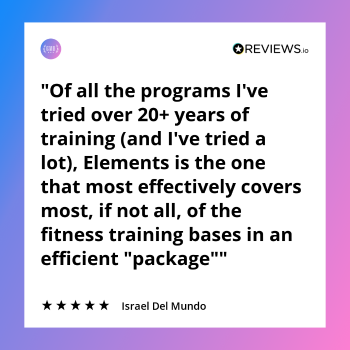 Starting out, it’s important that you build a foundation in the basics. Those basics are a combination of:
Starting out, it’s important that you build a foundation in the basics. Those basics are a combination of:
- Strength
- Flexibility
- Full body control
We recommend beginners start with Elements because it takes you through 4 distinct movements that help you address and build on the basics.
The movements are:
- The Bear, which helps you develop strength and stability through your shoulders and arms. You’ll also get a good hamstring and calf stretch as well.
- The Monkey, which helps you open up the hips and improves your balance and control. This move forms the basis for tumbling skills like the cartwheel.
- The Frogger, which helps you get comfortable in the squat position, strengthens your core, and helps build the upper body strength you need for inverted push-ups and handstands.
- The Crab, which helps you get stronger in the supine position, allowing for more control and coordination, and transfers over to build advanced skills like the L-sit.
🤔 How Much Progress Can You Make?
If you’re healthy and injury free, you can expect to squat more easily, be more comfortable balancing your body on all fours, and have more control over your movement within a few months.
Over the course of a year, you can expect to achieve at least one of the following improvements:
- Better balance and confidence moving more athletically
- Noticeable progress toward your chosen movement skill (e.g. squats, jumps, handstands)
- Improved body composition
- Better posture, more energy, improved mobility
Start On The Right Foot With a Foundation in the Basics
With Elements, you’ll build a foundation of strength, flexibility, and control, setting yourself up for a successful lifetime of staying fit and active.
